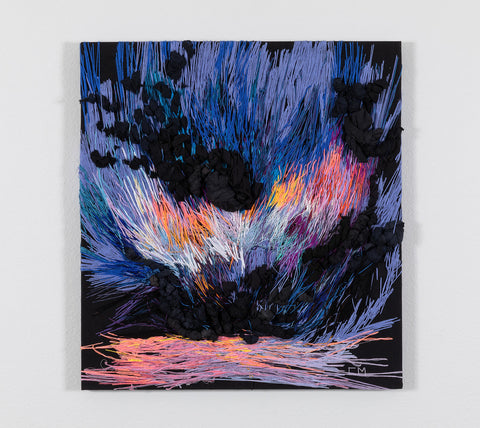Repaint History Call For Art Fund Recipient: Carmen Mardónez
Tell us about yourself.
I am a Chilean textile artist living in Los Angeles (CA) since 2017. I am the mother of a very energetic 3yo son, and I divide my time between mothering and creating. My work seeks to radically reimagine intimate spaces of memory, dreams, exploration, and discovery. In my current practice, I embroider on discarded bedding donated by my neighbors during the pandemic. These objects are witnesses of materialized, embodied repression, byproduct of centuries of indoctrination we, women, have experienced. They accompany our restless nights, when horrors and injustices do not give us truce. But above all, bed sheets are the space of our wildest dreams, utopias of liberation and sisterhood. Although I mostly do freestyle hand embroidery, lately I’ve been exploring other techniques including patchwork and textile sculpture. I am always open to keep experimenting with textiles. My work has been exhibited in South LA Contemporary-SoLA Gallery, The Museum of Latin American Art-MOLAA, and Brea Gallery, among others.

Image courtesy of the artist
Tell us about an encounter with art that has shaped your practice.
In 2016, I was working full time and writing a master’s thesis in social psychology, it was a really stressful time. A few years before I was majoring in arts but I didn’t complete that degree, and I stopped creating. But I started feeling the need to make some art, even if as a hobby. It was then that I discovered the work of Victor Espinoza, a Chilean embroidery artist. I got fascinated. The way Victor uses threads and colors is jawdroping. We met in person, and he showed me his pieces, explained his technique, and was very generous with all my questions. So I started embroidering again, and haven’t stopped since then.

Image courtesy of the artist
Which artists inspire your work?
I have a lot of artists I look up to! Everyday I try to be a better artist inspired by their work. The ones that come to my mind are Suchitra Mattai, Alia Ali, Chiachio & Giannone, Bisa Butler, Gabriel Dawe, Sonia Gomes, Ana Teresa Barboza, and Mónica Bengoa. I have so many more, but I have to cut the list at some point, hahaha. In general, I find inspiration in women artists, artists that work in really huge formats, and artists that use recycled materials or textile waste to create.

Image courtesy of the artist
What challenges have you faced throughout your career as an artist and what advice would you give to artists beginning their career?
It is hard for me to think about “my career” or give advice since I am just starting. But there are two things that have kept me afloat when I am about to give up. First, cultivating a relationship with other artists. Feeling that you’re not alone in your process and struggles helps a lot. Having a community of artists that are paying attention to your work and encouraging you is priceless. Given that, even before the pandemic, I was most of the time at home taking care of my son, social media has been my main channel to connect with other artists. I message people on Instagram, listen to podcasts, I meet people at exhibitions and, believe it or not, I’ve created some long lasting relationships this way. The second point is trying to create non-stop. I try to create something everyday, even if one stitch is all I can do. Everytime I have stopped for a day or two, starting over is much harder.

Image courtesy of the artist
How has your practice been affected by the turbulence and uncertainty of the past year? Has your work or the way you approach it changed at all?
This has been a really tough year. It will be three years since we last visited our families in Chile, our plan was to go last July but we couldn’t due to the pandemic. With my partner we don’t have family networks here, so there is no much option to have a break. It is exhausting. Art has kept me alive and sane during this time. Creating, experimenting, pushing my limits. Now that my son is a little older, I can spend more time embroidering and that’s great. Another thing that changed over the last year is that, initially, I used some recycled materials in my work, but it wasn’t a very conscious decision. Now in all my work there is textile waste, either old clothes or discarded pillows and bedsheets. I started collecting them from my neighbors during the lockdown, and something just clicked when working with those materials. It was a way of staying connected with my community while physically distanced. It also makes much more sense to work with repurposed materials given the amount of textile waste the world produces. Overall, I think all those changes to me practice will stay with me when the pandemic is over.

Image courtesy of the artist
What has your experience been in terms of mentorship and a sense of community in the art world, particularly among women artists?
It has been crucial to me. Not only being inspired by other women artists, but also the support I have received, everyone I have interacted with has been so kind and generous. For me, receiving their validation, so much love, and being recognized as a peer, has been very encouraging. Maybe this is silly, but every time an artist I admire likes one of my posts, or comments one of my pieces, I feel so seen. It is like a small boost, and a joy. I have never felt we are competing against each other.
A month ago Sarah Detweiler invited me to the #artnightgallery collective, and it has been a wonderful experience. We meet twice a week, work together, everyone in their own studio or at home, we connect over Zoom to talk and discuss whatever we feel like that day. It is invaluable to have a community of support with a shared passion. We can literally go from discussing the packaging and hanging of our pieces to our existential and maternal crisis.

Image courtesy of the artist
How will the Repaint History fund support your career?
At least in two ways. First, of course the money would help me a lot in this time that has been so difficult for everyone. I will be able to acquire some materials I have been waiting to buy, and probably to print cards and postals that I send to my collectors when they purchase a piece of mine. Basically, the fund is helping me to invest in my art and keep creating, even when the sales are slow. Second, and maybe even more important, getting this fund was such great news for my own confidence as an artist, I felt seen and valued, and it was a boost of motivation. So I am absolutely grateful for your support.


